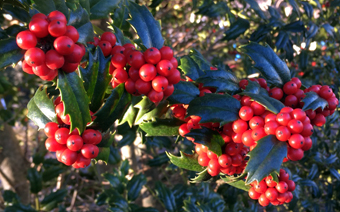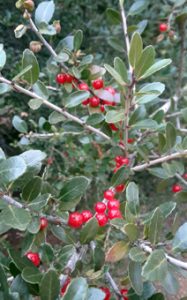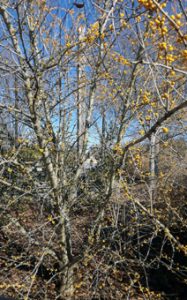If you think hollies are boring, think again! While known primarily as an evergreen holiday decoration in North America, hollies are actually quite varied in appearance and range worldwide. In fact, the Ilex genus is estimated to have 400-600 species of evergreen and deciduous trees, shrubs and climbers from tropical, subtropical and temperate regions. Also, Ilex is the only contemporary (living) genus in the Aquifoliaceae family. Huntsville Botanical Garden has 71 unique holly cultivars (including both evergreen and deciduous hollies) comprised of 11 different species plus hybrids in our plant collections. Here are a few standouts:
 Ilex x ‘Conot’ PP#12010, Patriot™ Holly (Located in the Space section of the Children’s Garden)
Ilex x ‘Conot’ PP#12010, Patriot™ Holly (Located in the Space section of the Children’s Garden)
Patriot™ Holly is a cross between ‘Mary Nell’ and ‘Nellie R. Stevens’ hollies that resulted in medium-sized pyramidal holly with smaller than average serrated leaves and a heavy berry set without relinquishing its rich dark green foliage. It will fruit without a male pollinator, but fruit set is enhanced when one is present. It prefers full sun and well-drained acidic soils. Patriot™ matures to 12 feet tall and 6 feet wide and responds well to shaping at an early age.
 Ilex vomitoria, Yaupon Holly (Located behind the Propst Guest Center, multiple locations)
Ilex vomitoria, Yaupon Holly (Located behind the Propst Guest Center, multiple locations)
Ilex vomitoria, commonly known as Yaupon holly, is native from Virginia to Florida, Arkansas and Texas in sandy woods, dunes, open fields, forest edges, and wet swamps, often along the coastal plain and maritime forests. This thicket-forming, broadleaf evergreen shrub or small tree typically grows in an upright, irregularly-branched form to 10-20 feet tall and to 10 feet wide. There are also numerous cultivars available that form small (4 x 4 feet) shrubs with dense canopies and do not fruit. The Yaupon holly is prized for its glossy dark evergreen leaves, small fragrant (inconspicuous) flowers that bloom in the spring and shiny red drupes that attract birds in the winter. This species is dioecious and female plants must be pollinated with a compatible male holly in order to bear fruit. The leaves were used by Native American Indians to make a ceremonial cleansing drink for which the specific epithet is descriptive. The genus name comes from the Latin name Quercus ilex for the holm oak in reference to the similarities of the leaves.
 Ilex decidua ‘Finch’s Golden’, Yellow-berried Possumhaw Holly (Located in the Children’s Garden)
Ilex decidua ‘Finch’s Golden’, Yellow-berried Possumhaw Holly (Located in the Children’s Garden)
Finch’s Gold Possumhaw Holly is a fantastic feature in fall and winter gardens – its bright yellow fruit will brighten up the winter landscape for months (if the birds don’t get them first!). Possumhaw Holly is a large deciduous shrub or small tree growing to 15-20 feet tall and usually has red fruit that matures in the fall and persists through winter. It occurs on limestone glades and bluffs, along streams in wet woods, and in lowland valleys, drains and swamps in southeastern North America. It has few pests or diseases and is quite tolerant of a wide variety of growing conditions, including heavy clay soils and air pollution. ‘Finch’s Golden’ is a yellow-“berried” form with golden colored drupes that cover the stems if planted in full sun. This native holly also grows well in part shade, but fruiting is reduced. It needs a male holly with overlapping bloom period (April-May) in order to bear fruit, but there are many compatible species.
 Ilex x ‘Conin’ PP# 9486, Robin™ Red Holly (Located at the Celebration Garden)
Ilex x ‘Conin’ PP# 9486, Robin™ Red Holly (Located at the Celebration Garden)
Robin Holly is a member of the “Red” series of hybrid holly cultivars, all of which are seedling selections from Ilex x ‘Mary Nell’. They were selected for their growth habits as well as their reddish colored new growth. Robin™ is considered by many to be one of the more impressive of these selections due to its similarities to ‘Nellie Stevens’ Holly but its smaller stature (15 x 8 feet). Robin™ Holly is a fantastic choice as either a specimen plant or screen planting as we have done at the Celebration Garden and Kitchen Garden.
![]() Ilex verticillata ‘Nana’, Red Sprite Winterberry Holly (Located on the Bush Azalea Trail)
Ilex verticillata ‘Nana’, Red Sprite Winterberry Holly (Located on the Bush Azalea Trail)
Ilex verticillata, commonly called winterberry, is a deciduous holly that is native to eastern North America where it typically occurs in swamps, damp thickets, and riparian wooded areas forming large thickets or colonies. This slow-growing, deciduous shrub has an upright-rounded habit that typically grows 3-12 feet tall. Fall color is usually unremarkable, but inconspicuous greenish-white flowers in late spring, if pollinated, give way to a crop of bright red drupes in fall. Berries are quite showy and will persist throughout the winter and into early spring providing considerable interest to the winter landscape. One male winterberry holly, such as Ilex verticillata ‘Jim Dandy’, is usually sufficient for pollinating 9-10 female winterberry hollies. The specific epithet from Latin means “whorled” in reference to the arrangement of fruits around the stems.
 Chimonanthus praecox, Wintersweet (Located on the upper Dogwood Trail)
Chimonanthus praecox, Wintersweet (Located on the upper Dogwood Trail)
Another plant worth seeing (or smelling) in January is the Wintersweet on the Dogwood Trail. This large deciduous shrub in the Sweetshrub family (Calycanthaceae) has an amazing fragrance you won’t want to miss! Chimonanthus praecox, commonly known as Wintersweet or Chinese allspice, is a deciduous shrub that typically grows 10-15 feet tall and to 8-12 feet wide. It is native to forested areas of China. Very fragrant, small, yellow flowers with purple centers bloom in the winter (usually January, here) on leafless branches. The genus name comes from the Greek words cheimon meaning winter and anthos meaning flower, and the specific epithet means “very early” referring to its bloom time. It prefers full sun but needs a protected location in Zones 6 and 7 in order to minimize possible frost damage to flowers.

